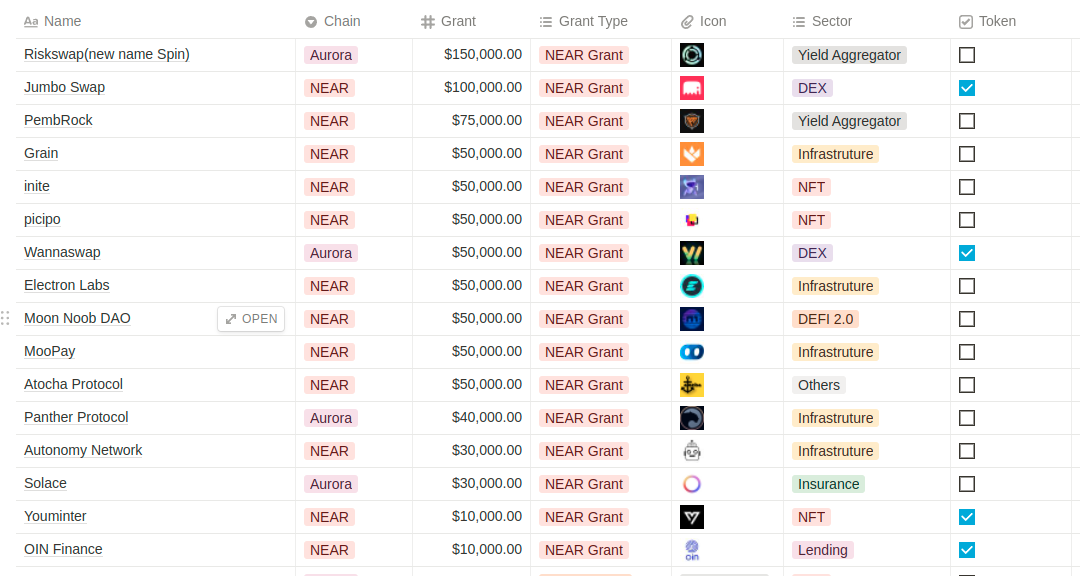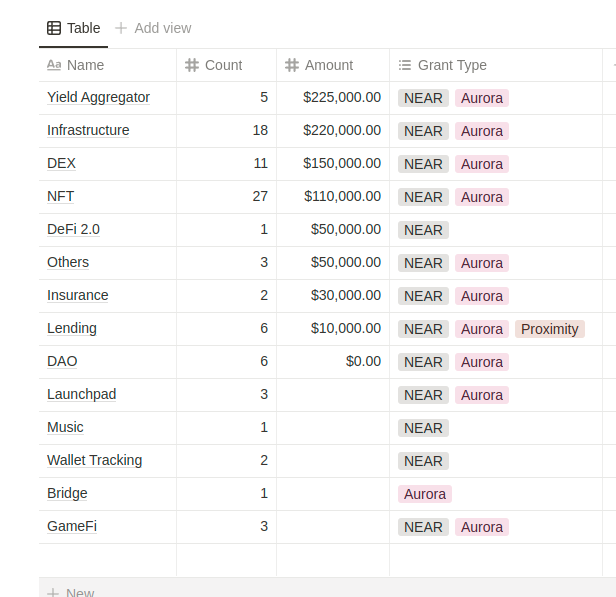This post was originally published on my Substack on April 15, 2022. I am moving all my previous posts to Mirror (because it’s awesome!) but you can check out the original here if you are into that kind of thing.
NEAR: Ecosystem Fund Review
Progress continues moving forward in documenting more and more of the Grants and Incentives Programs in the space. I have made some nice strides (at least, I think) in building out my public database and starting conversations with a few more of the larger Ecosystem Funds that I will be reporting on in the days ahead.
This time we’re taking a look at NEAR with some analysis on their Ecosystem Fund that was announced in October of last year to the tune of $800M. We’ll take a look at the current rate of distribution and highlight some of the projects that were granted. We’ll also review a bit on how governance works and talk about where you can look to learn more about NEAR.
Let’s dive in…
Background
NEAR was founded back in 2017 by Illia polosukhin and Alexander Skidanov with a mission to develop a highly scalable network that could build upon previous innovations but take it one step further in terms of performance and overall scalability.
According to CBInsights they have raised ~$521M to date in funding including the most recent $350M that was announced just a few days ago. Looking through the list of backers it reads like a who’s who of prominent traditional and crypto VC’s and that isn’t too surprising when you start to look under the hood of what NEAR is doing.
NEAR touts itself as a performant, highly efficient layer one network that uses sharding to achieve relatively high transactions per second (TPS). It is a delegated proof of stake requiring validators to stake $NEAR to participate like many other POS networks.
NEAR’s secret sauce, Nightshade, is a dynamic re-sharding mechanism that allows the network to be readjusted based on utilization allowing for reduced cost of use while maintaining high TPS. Total big brain stuff.
If you want to learn more about these kinds of details in addition to bridge options, network comparison and tokenomics you can check out the this post from the good folks at Nansen who will do a much better job of giving you that info than me.
Organizational Structure
NEAR describes its structure online as a collective, a foundation and a blockchain. For the purposes of this research we are looking specifically at their foundation as that is the entity that is responsible for governance and oversight of their ecosystem fund and grants programs.

The NEAR Foundation was created in 2019 to help steward and develop the ecosystem that would start to form. Reading through their documentation and site their vision seems well laid out. I also appreciated the fact that they state their purpose, which is something that seems missing all so often in our highly transactional world of today:
“Our purpose is to enable community-driven innovation to benefit people around the world.”
We are seeing building support for the NEAR Ecosystem not only in the charts (number going up) but in recent funding rounds like the $350M that was just announced that included big names such as Tiger Global, FTX Ventures, Dragonfly Capital, and a few others. I have the Twitter announcement linked here for some additional details if you are interested in checking it out.
Now that you have a bit of the background on NEAR including technology and their foundation let’s dive in a bit to their ecosystem fund and how things have been progressing since their initial announcement in October of 2021.
Ecosystem Fund
Overview
NEAR’s founder Illia polosukhin announced their ecosystem fund at their conference (NEARCON) back in October of 2021 to the tune of $800M in total incentives available to anons that want to help build out the ecosystem.
If you take a look around on NEAR’s wiki you can find some details on the grants program. At a high level it states these three main objectives:
- Provide funding to accelerate the growth of the NEAR ecosystem and broader community
- Support the development of necessary and value add infrastructure / tooling to support continued innovation
- Attract and reward a diverse set of open source driven projects and developers that build on NEAR
The program is structured to allow for funding across these four main categories.
Aside from the NEAR Foundation there are also funds available through these sources all with additional details on the site mentioned above. I wasn’t able to find any details or lists of projects or initiatives funded through these entities that were directly tied to NEAR so you’re on your own there, anon.
- NEAR Community Fund
- Open Web Collective Fund
- NEAR Asia Fund
- Cypherpunk Guild
- DAO Ecosystem
Distributions
The incentives for these programs are paid out in $NEAR, but accounted for on a $USD cost basis, meaning recipients would be granted an amount equivalent to $NEAR based on current market price at time of allocation. It will be interesting to see if this changes and they start to use their newly announced stable, $USN, to provide funding moving forward.
Unfortunately, not all the allocation consumption totals for the program are not publicly available like others I have reviewed, however, I was provided a link to a public Notion site where you can view the name of the grant recipients who have publicly announced along with some other relevant details:
Projects Granted by NEAR/Aurora
The current process for fund governance is driven by NEAR Foundation and explained to me to have a due diligence and evaluation process prior to allocation.
Funds are distributed on a milestone basis once agreed upon goals for project success are met or progressed. The success criteria for each of these differs between the projects and would be at the discretion of decision makers at NEAR Foundation to define and ensure alignment to overall ecosystem goals and objectives.
The address where it was indicated to me that these funds are paid from is located below:
It should also be noted that prior to the $800M ecosystem fund announcement, NEAR had already spent $45M across more than 120 projects, including Core Protocol Infrastructure Grants.
Funding Breakdown
As mentioned not all the allocation consumption totals for the program are public so only partial information is available. At time of writing there were 85 total grants listed with 16 of them showing funding totals that amounted to ~$845K.
The amounts granted range from low 5 digits all the up to $150K but I have to believe some higher amounts have been given out under the $800M allocated for the program. I have a snapshot below of the projects where funding amounts are available. You can see the entire list on my notion site if that kind of thing excites you.

Keep in mind that NEAR doesn’t list the total amounts for all projects so the monetary totals listed only take into account projects where funding totals were public.
NEAR is breaking up their funding allocations into a few different categories based on the Notion page that I shared above. I took some time to sum a bit of the information in their site and have below a breakdown of these categories and current totals.

Keep in mind that NEAR doesn’t list the total amounts for all projects so the monetary totals listed only take into account projects where funding totals were public.
NEAR seems to be investing the most in building the core infrastructure and investing in DEX’s, yield aggregation, and NFT’s which makes alot of sense as you create a foundation (pun intended) for long term growth and sustainability.
I also really enjoyed this thread on some of the more promising projects in the ecosystem that I think is worth checking out if you want to dive a bit deeper on that front.
Finding The Information
I will say I was very pleased with the help I received from the NEAR Team. I asked some questions in the Discord and quickly found my way to someone that was willing and able to help. One of the most enjoyable parts of this entire project I underestimated was meeting anons that are contributing and stewarding these systems. If I had to give any suggestions it would be to be more detailed with the data available and to have some kind of trail linked to the notion site that shows the approval process. I would also recommend some kind of success metrics that these grants are tied back to that can be measurable over time.
How to Apply
If you might be interested in applying you can hit the links below for more details. If questions arise during that process make sure to check out the Discord and they can help.
Closing
Progress has been picking up and I feel I am hitting a stride (famous last words, I am sure) in building out my my research site, The Common Good. I even got a RT and follow from the legendary Gabagool.Ξth after sharing my site on the this post … won’t lie totally made my day.
The research will continue with a few more funds in the hopper that I hope to publish in the coming weeks. Thanks to all of you for the support!
Until next time frens,
- Sov